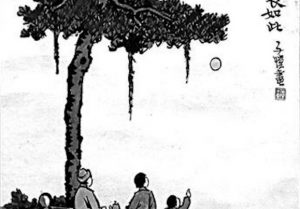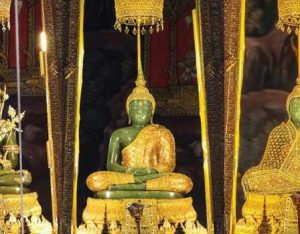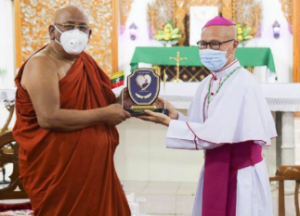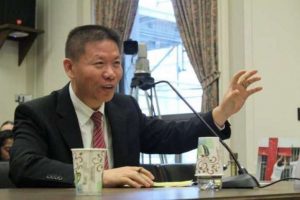
More than a thousand Buddhist monastics and lay practitioners gathered at Tu Hieu Temple, in the central Vietnamese town of Hue, on Tuesday to commemorate the passing and continuation of the Zen master, teacher, and engaged Buddhist Thich Nhat Hanh. Sister Chan Khong, 85, who worked closely alongside the revered teacher since the earliest days of his movement and social engagement in the West was in attendance.
A beloved teacher, spiritual leader, poet, and peace activist, Thich Nhat Hanh—known affectionately among his followers as Thay—died on 22 January 2022 at the age of 95. Renowned for his insightful Dharma teachings and writings on mindfulness and peace, he established a global engaged Buddhist community that has flourished into the 21st century.
After completing silent walking meditation around Tu Hieu Temple, the lay and monastic followers gathered to offer prayers to their teacher and a formal memorial ceremony. In the meditation hall of Tu Hieu Temple, simple offerings of tea and vegetarian dishes were presented symbolically before an alter.
Some years earlier, in anticipation of his passing, Thich Nhat Hanh wrote for his followers:
“If one day I die, don’t build me any tomb or tower. It’ll cost money, it’ll cost people’s land, and our people are still very poor. Cremate me. Take my ashes to Plum Village monasteries around the world and scatter them on your meditation walk roads so that every day I am still with you on our walking meditation.”
(VnExpress International)
As part of its own activities to mark the occasion, the Plum Village Buddhist community that Thay established in southwestern France has shared “Three Precious Memories of Thich Nhat Hanh” from Thay’s senior monastic students on their website.
Born Nguyen Xuan Bao in central Vietnam on 11 October 1926, and ordained as a monk at the age of 16, Thich Nhat Hanh recevied global recognition as an influential Zen teacher, a poet, and the author of more than 100 books, which have since been translated into over 40 languages. His best-loved books include the bestselling The Miracle of Mindfulness, Peace is Every Step, and How to Love. As an unwavering advocate for peace, Thay was influential in the anti-war movement, encouraging non-violent protests during the American war in Vietnam. Before leaving Vietnam, he spearheaded a Buddhist movement in the south calling for a negotiated end to the bloody conflict. In 1967, Thich Nhat Hanh was nominated for the Nobel Peace Prize by the civil rights leader Dr. Martin Luther King, Jr., who told the Nobel committee: “I do not personally know of anyone more worthy of the Nobel Peace Prize than this gentle Buddhist monk from Vietnam.” (Plum Village)
Thich Nhat Hanh went on to found the Order of Interbeing and the Unified Buddhist Church, and in 1982 formed the Plum Village Buddhist Center near Bordeaux in southwestern France with Sister Chan Khong. Establishing a profoundly deep legacy of teachings, writings, and public works spanning decades, Thay became a central figure in the transmission of Buddhism to the West and in marrying an authentic Zen tradition and lineage with a progressive approach to addressing issues such as social activism, peace advocacy, science versus faith, and religion versus spirituality.
As a leading light in the modern mindfulness movement in the West, Thay taught many of today’s foremost mindfulness teachers and developed healing methodologies that have since been incorporated into mainstream clinical psychology to treat depression, anxiety, and stress.
Following a severe brain hemorrhage in November 2014, Thay was hospitalized in France. After months of rehabilitation, he returned to his Plum Village monastic community in April 2015, where monastic attendants and visiting medical professionals continued to aid his recovery. In July of the same year, he was flown to San Francisco to undergo a more intensive rehabilitation program, and in September 2015, Thay spoke his first words since his stroke. The following January, he was allowed to return to Plum Village, where he remained under the care of the members of his community.
In December 2016, two months after his 90th birthday, Thay communicated a clear and determined wish to travel from France to Thailand in order to be closer to his homeland. Thay was able to make his first visit to Vietnam in more than a decade in August 2017, spending several days in Da Nang before visiting his hometown in nearby Hue and paying respects at his ancestral shrine and his lineage’s root temple, Tu Hieu, of which he remained the abbot. Thay returned to Tu Hieu Temple in October 2018 to spend the remainder of his life in the loving care of his closest followers until his passing on 22 January 2022.
Thich Nhat Hanh’s work and legacy are continued by the International Plum Village Community of Engaged Buddhism, a global grassroots network comprising more than 1,000 local mindfulness groups, dozens of meditation centers, and 10 monasteries in the US, Europe, and Asia, as well as countless followers and practitioners around the globe.
This body is not me. I am not limited by this body. I am life without boundaries. I have never been born, and I have never died.
(Thich Nhat Hanh)
See more
Plum Village
Zen Master Thich Nhat Hanh’s 1st death anniversary marked in Hue (VnExpress International)
Hơn 1.000 phật tử dự lễ giỗ đầu thiền sư Thích Nhất Hạnh (VnExpress)
Related news reports from BDG
A Cloud Never Dies: Plum Village Releases Thich Nhat Hanh Documentary
Coming & Going in Freedom: Casting Thich Nhat Hanh’s Ashes
Thousands Gather for the Funeral of Thich Nhat Hanh
Plum Village Announces the Passing of the Internationally Beloved Buddhist Teacher Thich Nhat Hanh
Ven. Pomnyun Sunim: Upon Hearing the News of Ven. Thich Nhat Hanh’s Passing
Sulak Sivaraksa: Thich Nhat Hanh – My Friend and My Teacher
Ven. Bhikkhu Sanghasena: The World Has Lost Another Beautiful Flower
Related features from BDG
Buddhistdoor View: Discourse and Praxis – The Interconnected Legacy of Thich Nhat Hanh
The Cloud Is Not Lost – In Honor of Thích Nhất Hạnh
















